Abstract
Grafting is one of the main techniques used in intensive tomato cultivation to address abnormal weather, diseases, insect pests, and continuous cropping problems. In recent years, due to agricultural labor constraints, the industry has needed to make use of more machinery. In this study, a clamping and cutting arrangement device for Solanaceae scion and stock seedlings was developed; it included a UR5 robotic arm to realize the automatic clamping and cutting of multiple seedlings, to facilitate the mechanized grafting of seedlings. The clamping success rate of eggplant and tomato seedlings using this device was 99%. When working with four seedlings in a single operation, the oblique-cutting success rates for eggplant and tomato seedlings were 97.76% and 94.55%, respectively. Moreover, 404 eggplant seedlings and 384 tomato seedlings could be worked with in 1 h. After the splicing and grafting process had been completed, the survival rate of the grafted seedlings was 85%. The simple device structure could be used by the industry to assist operators in clipping and cutting seedlings, reduce the complexity of grafting operations, shorten training times, address the problem of labor constraints in Taiwan’s agricultural industry, and improve product quality and efficiency.
1. Introduction
Tomatoes are one of the most popular and important vegetables in the world. According to the World Food and Agriculture Organization (FAO) 2019 statistics, the world tomato-planting area was 5,030,000 hectares, the harvested volume being approximately 180,766,000 tons. Moreover, the harvest area and volume are increasing year-on-year [1]. The use of rootstock varieties—with their excellent root vigor which absorb water and nutrients effectively—can be used to reduce the quantity of chemical fertilizers, reduce the frequency of pesticide application, increase crop yields, reduce environmental pollution [2,3,4,5], and reduce various abiotic and biotic stresses under intensive cultivation [6,7]. The most serious problems associated with tomato planting are those of soil-borne diseases and insect pests. Before the popularization of grafting technology, chemical disinfectants—such as methyl bromide—were generally used to eliminate diseases and insect pests. Although the impact of these substances is remarkable, it can have serious environmental ramifications. Consequently, environmental protection legislation has banned such practices in many countries [8,9], and grafting has become prevalent in the production of tomato seedlings. Compared with natural screening, breeding, or species hybridization, grafting technology is a fast and effective method to obtain the desired crop characteristics to solve current cultivation dilemmas [10].
The rootstocks of grafted tomato seedlings used at different latitudes can differ considerably. In particular, verticillium wilt, wilt disease, root nodule nematode, and white silkworm disease can be overcome in temperate regions by grafting appropriate tomato rootstock varieties (such as Maxifort). In subtropical and tropical regions, bacterial wilt and waterlogging problems can affect tomato production, and eggplant rootstock varieties—such as EG203, which is resistant to bacterial wilt and waterlogging—can be used for the grafting process [11]. Consequently, grafted tomato seedlings in temperate regions are mainly tomato–tomato grafted seedlings, while those in subtropical and tropical regions are mainly tomato–eggplant grafted seedlings. In short, the development of cultivation strategies that suit local conditions, based on climatic differences and industrial management models, is essential.
The traditional grafting operation is a manual process, a task that requires attention, skill, and training. After accumulated experience, the yield rate of grafted seedlings can be maintained at an acceptable level. In Taiwan, professional grafters can produce 180–200 grafted seedlings per hour, with a survival rate of 80–90% [12]. Moreover, there is a seasonal demand for grafted tomato seedlings, with July–September being the peak season. Based on a survey by the Agriculture Committee of the Executive Yuan, the agricultural employment population in Taiwan in 2021 only accounted for 4.7% of the total employment population. Among those engaged in agriculture, 64% are over 50 years old, and 20% are over 65 years old. The agricultural industry faces the dilemma of an aging population in rural areas, a lack of labor, and difficulties in training professional operators, resulting in existing operators having to work intensively, for long periods of time. Consequently, the use of machinery for grafting operations has become a growing trend, as it can solve the problem of labor shortages, reduce production costs, and improve the work environment [13].
The three most important tasks required of grafting machines include the clamping and positioning of seedlings, beveling, and grafting. However, current grafting methods in Taiwan make the mechanization of grafting very difficult, as the country is accustomed to using tomato scion to graft the eggplant root stock. The appearance and size of the two differ, making the grafting process difficult. Moreover, producers usually consider factors such as the high production costs and low prices of grafted seedlings, which means that the mechanical-grafting success rate needs to be more than 95% to produce economic benefits.
In terms of grafting materials, open-type grafting clips are not accepted by many Taiwanese farmers, the price of open-type grafting clips being 10 times higher than that of casing-type grafting clips. Moreover, casing-type grafts also have a shorter healing period and can be shipped within 12 days of grafting; some nurseries even shipping within 9 days. For grafted seedlings produced using open-type grafting clips, the delivery period cannot improve upon that of casing-type grafted seedlings, and cultivators may be reluctant to use open-type grafting clips which may leave beveled sections prone to blackening or bacterial infection. Consequently, this study proposed a new model to develop a grafting machine suitable for Taiwanese cultivators. Additionally, a model able to work with multiple seedlings simultaneously could improve the operational efficiency, providing cultivators with sufficient reason to use the proposed casing.
Agricultural machinery can be divided into three broad research and development categories—that is, fully automatic, semiautomatic, and auxiliary equipment [14]. Table 1 shows the current research and development Solanaceae grafting machinery models in various countries, most of which are semiautomated technical systems. The method of operation has the operator supplying seedlings, and the grafting machine performing tasks such as clipping, cutting, and grafting, effectively improving the efficiency of grafting operations. Although fully automatic grafting equipment is available, it can be extremely expensive, and seedlings must be of high uniformity. Moreover, the operating process can be complicated, so it is rarely used domestically. In European countries, such as the Netherlands, the seedling industry is more mature. Due to the stable climate and the cultivation of seedlings in precision greenhouses, the characteristics of seedlings are consistent, and the profitability of working with massive quantities can outweigh the cost of mechanization. Taiwan is a subtropical region with a relatively complex climate, making it more difficult to control the traits of seedlings produced in greenhouses. Moreover, most seedling producers in Taiwan cannot afford high-cost greenhouse equipment and automatic grafting technology. Producers are more likely to use low-cost and simple-structured auxiliary equipment—as such, the aim of this study is to develop labor-saving machinery that meets the needs of domestic producers.

Table 1.
Models of tomato grafting machines developed by various countries.
The clamping and cutting arrangement device for Solanaceae scion and stock seedlings is a simple mechanism. Combined with a power source, it can clamp multiple seedlings and be inclined at a fixed angle, making it suitable for different Solanaceae crops, which could improve the automation of grafting operations and improve production efficiency. This study continues the development and application of the clamping and oblique cutting arrangement-type device for Solanaceae panicle stock and seedlings [15], improving the device and collocation structure (detailed), so that the overall device can better meet the needs of Taiwan seedling producers.
2. Materials and Methods
2.1. Institutional Design and Operational Process
The aim of this study is to mechanize the grafting of panicle and stock seedlings, pick seedlings from plug trays, transport seedlings, and obliquely cut seedlings, to improve the operational efficiency of the grafting process. The overall structure comprises a clamping and cutting arrangement device for Solanaceae scion and stock seedlings, combined with a UR5 robotic arm, programmable controller, air pressure supply component, plug-tray assembly, and cutting table assembly (Figure 1). The device design features are as follows:

Figure 1.
Architecture diagram. (1) UR5 robotic arm, (2) clamping structure, (3) chamfering structure, (4) plug tray of scion and stock, (5) placement zone, (6) control box, (7) mobile base.
- Multiple-type grafting operation: Compared with clamping a single plant before beveling, by clamping multiple seedlings—that is, four or eight at a time—the operational efficiency of the grafting process can be improved.
- Standardization of clamping and chamfering: the proposed device can align the seedlings, position them, and produce a consistent chamfering angle.
- Plug-tray specifications: The proposed device complies with the plug-tray specifications used by seedling growers in Taiwan—that is, it caters to 104 grid plug trays (8 × 13) in bulk.
- Applicable to tomato seedlings and eggplant seedlings: The proposed device is not limited to the use of single crop seedlings, its operation being more flexible.
The clamping and cutting arrangement device for the Solanaceae scion and stock seedlings can be divided into two parts—that is, the clamping structure and the chamfering structure. The gripping structure (Figure 2) can be equipped with different power sources. The claw head is designed to simulate the action of three fingers gripping objects and is designed in an array structure; Belforte et al. also have a similar clamping method [16]. Based on the number of claw heads, up to eight seedlings can be clamped in a single operation. To simultaneously hold multiple seedlings, the claw head is designed into a ㄑ-shaped structure, so that the seedlings are concentrated in the center of the ㄑ-shape when clamping, the positioning effect being very helpful when oblique cutting of the seedlings is conducted. Additionally, the contact surfaces of the claws holding the seedlings are equipped with soft pads—designed with a hollow center—to maintain a steady grip of the seedlings and to avoid damaging them. Moreover, to increase the elastic space for clamping, seedlings with different stem diameters can be clamped at the same time.

Figure 2.
(a) The clamping device for the scion and stock. (1) Eight claws. (2) Four claws. (b) Image of the clamping device clamping the seedlings.
The chamfering structure (Figure 3) is equipped with a thin double-guide rod pneumatic cylinder (brand, MCGJ-12-12-10) and up to eight seedlings can be chamfered in a single operation. The grooves of each knife holder and anvil are designed to be inclined at 20°, and the slanted seedlings are fixed at 20°. Previous studies suggest that increasing the bevel angle could improve the graft survival rate—that is, a bevel angle of 10–30° could achieve a survival rate of more than 90%. For grafting rootstocks and scions of different stem thicknesses, a bevel angle of 20–40° provides better results, as the bevel cut can produce a larger area than a flat cut, there being more cells between the rootstock and the scion contact, resulting in better healing and better tensile strength [17,18].
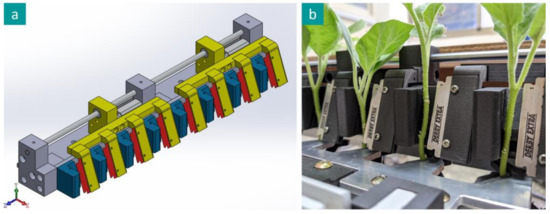
Figure 3.
(a) The chamfering structure; (b) seedlings being moved to the chamfering structure.
The experimental process was based on the artificial grafting method adopted by seedling growers in Taiwan, where the grafters first bevel the root stock and apply the casing, after which the scion is beveled and inserted into the casing, so that it is in contact with the cutting surface of the root stock, completing the grafting process. In this study, the proposed device was used to obliquely cut the root stock, as shown by the purple route outlined in Figure 4, the grafters putting the beveled root stock into the casing. At the same time, the scion is obliquely cut, as shown by the orange route in Figure 4, the grafter putting the beveled scion into the casing, a time-consuming cycle. The process for each seedling is an independent operation, the root stock or scion being treated according to the speed of the grafter.
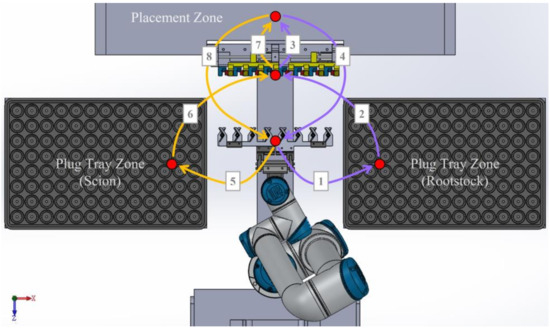
Figure 4.
Device operational flow chart. The purple route (1–4) denotes the root anvil operation, and the orange route (5–8) denotes the scion operation, in this cycle.
This single operation can be outlined as follows: Start the action—grip the seedlings —transport the seedlings—cut the seedlings obliquely—transfer the seedlings—place the seedlings. Consequently, the UR5 robotic arm can be used as the conveying mechanism, the detailed process settings of which are shown in Figure 5. Moreover, the operational processes for the root stock and the scion are the same and the coordinates of the starting point are the same (although the coordinates of other control points differ).
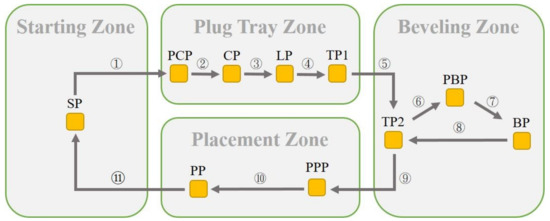
Figure 5.
The operational process of the robotic arm. SP: Start point; PCP: Pre-clamping point; CP: Clamping point; LP: Lift point; TP1: Transport point 1; TP2: Transport point 2; PBP: Pre-beveling point; BP: Beveling point; PPP: Pre-putting point; PP: Putting point, acting from ① to ⑪.
2.2. Test Materials and Grafting Conditions
In this study, the root stock was selected from the “Asian Vegetable EG203” eggplant variety, and the scion was selected from the “Yunv” tomato variety. The seedlings tested were all obtained from the Shangsheng Seedling Farm in Chiayi County. The rootstock and scion grow with similar traits, having a straight appearance, a stem diameter of 2–3 mm, and a seedling age of 4–6 weeks.
The grafted plants are best placed in a higher relative-humidity and constant-temperature environment to reduce the evapotranspiration of the scion, until the vascular tissue of the rootstock and scion heals and restores water transport. During plant healing and acclimatization, the increasing presence of light gradually improves the survival rate [19,20]. In this study, the environmental conditions during the grafting operation were maintained in the 25–28 °C range, after which the completed grafted seedlings were moved to the growth box. The environmental conditions in the growth box for the healing and acclimation process were maintained at a temperature of 25 ± 1 °C and a relative humidity of 90 ± 5%. The growth box was placed in a dark room within 3 days of grafting to allow the grafted seedling wounds to heal. After the 4th day, the grafted seedlings were cultivated with 10 μmol⋅m−2⋅s−1 light for 3 days, then daily light for 12 h and a dark room for 12 h, then normal light (approximately 40 μmol⋅m−2⋅s−1 ) after the 7th day, domestication being completed by the 14th day.
2.3. Module Optimization Experiment
To determine the optimal combination of the arrayed clamping device for panicle seedlings of Solanaceae, the oblique cutting device, and other mechanisms, a clamping test and oblique cutting test were conducted, the test methods being as follows:
2.3.1. Clamping Test
Two different power sources were used in the clamping structure—namely, the RG2 electric gripper and the MHL2 pneumatic gripper, as shown in Figure 6—and gripping tests for the 4-jaw and 8-jaw type structures were conducted. The clamping method shown clamps the seedlings in a matrix sequence. One plate has 104 holes (8 × 13), so the 4-claw type structure clamps 26 times, and the 8-claw type structure clamps 13 times, as shown in Figure 7. In this mode, one plate of tomato scion and one plate of eggplant root stock were tested, the success and failure of each clamping being recorded along with the reasons for failure. We then compared the clamping success rate of the 4-claw type structure and the 8-claw type structure using two different clamping power sources as well as the success rate of clamping different types of seedlings, before selecting the module with the best clamping ability for subsequent experiments.
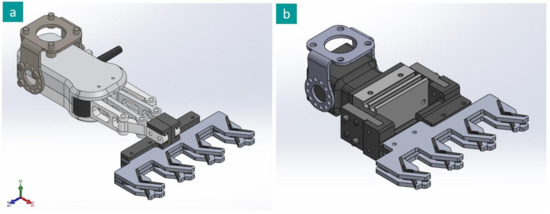
Figure 6.
Grippers with two different power sources. (a) RG2 electric gripper (open and close with an arc movement); (b) MHL2 pneumatic gripper (open and close with a parallel movement).

Figure 7.
The path of the clamping structure. (a) Four claws; (b) Eight claws.
2.3.2. Oblique Cut Test
The oblique cutting structure was designed using two commercially available razor blades—that is, a short-blade type and a long-blade type, as shown in Figure 8. The oblique cutting rate, operating efficiency, and survival rate of the two types of grafted seedlings were compared, the best clamper module in the clamping test being selected. The short-knife type and long-knife type were used to obliquely cut the tomato scion and eggplant root anvil, respectively, using three sockets, in triplicate experimentally. During the test, the successes and failures of each operation were recorded, along with the reasons for their failures. The machine was also equipped with a grafter to graft the obliquely cut root stock and scion in sequence. There were two timers used during the test, one recording the time for each operation, the other recording the time for a plate of grafted seedlings to be completed. The completed grafted seedlings were then moved to the growth box, healed based on the healing and domestication conditions, observed, and recorded daily, the grafted survival rate being calculated after domestication.
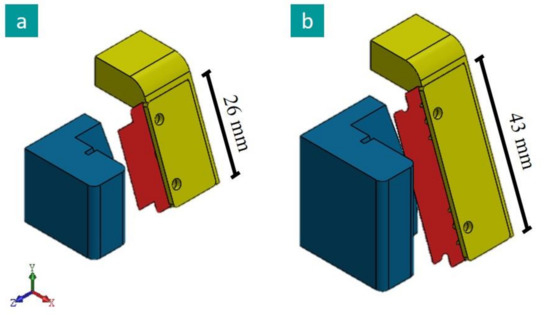
Figure 8.
The two types of cutters for the oblique cutting structure. (a) Short knife; (b) long knife.
The experimental data were analyzed using the IBM SPSS Statistics v21 software application, the percentage data first being converted using the Bliss formula tables, after which analysis of variance (ANOVA) was performed [21]. The gripping test used two-factor ANOVA to compare the gripping success rates of the RG2 electric gripper and the MHL2 pneumatic gripper, so that the influence of crops and gripping types on the gripping success rate could be determined. The oblique-cutting success rate in the oblique-cutting test was analyzed using ANOVA to determine the significant differences between the mean values (p < 0.05). Additionally, the effect of crop and cutter type on the oblique-cutting success rate was determined using two-factor variance analysis. The operational efficiency and grafting survival rate were analyzed using a t-test statistical test, the significant differences between the two average values being compared (p < 0.05).
3. Results and Discussion
3.1. Clamping Test
The clamping structure of the proposed clamping and cutting arrangement device for Solanaceae scion and stock seedlings was designed with four claws and eight claws, and the clamping power source was selected from the RG2 and MHL2 grippers, being combined into four modes. The clamping results of the eggplant and tomato seedlings are shown in Table 2. Using the same clamping structure and power source, the three modes—that is, the 4-jaw RG2, 4-jaw MHL2, and 8-jaw MHL2 modes—exhibit no significant difference in clamping different seedlings, the success rate being over 98%. The success rates of the 8-jaw RG2 mode for clamping eggplant and tomato seedlings are 60.58% and 85.58%, respectively, with significant differences—that is, it performs better for clamping tomato seedlings. Comparing the four modes for clamping eggplant seedlings, there is no significant difference among the three modes (4-claw RG2, 4-claw MHL2, and 8-claw MHL2), but there are significant differences using the 8-claw RG2 mode. However, there is no significant difference among the four modes for clamping tomato seedlings.

Table 2.
A comparison of the seedling-clamping success rate between clip type and gripper type.
Compared using two-way ANOVA, for the clamping of eggplant seedlings there is a correlation between the gripper type and power source (p < 0.001), different gripper types (p < 0.001) and different power sources (p < 0.001) being significantly different. For the clamping of tomato seedlings there is a correlation between the gripper type and the power source (p = 0.04), there being significant differences between the different gripper types (p = 0.01) and different power sources (p < 0.001). It is evident from the above that the 4-jaw clamping structure is more consistent than the 8-jaw clamping structure. It is speculated that the greater the number of clamping jaws, the smaller the force distributed by the single-jaw clamping process, resulting in a decrease in the clamping success rate. The MHL2 pneumatic gripper and RG2 electric gripper have different gripping results due to their different power sources.
There are two reasons for seedling clamping failures:
- Seedlings loosened when pulled up from the plug, accounting for 6.37% of the total clamping, which occurred when the RG2 electric clamper clamped eggplant seedlings.
- The seedlings were located at the edge or corner of holes, so the clamping structure could not clamp them effectively, accounting for 1.2% of the clamping total. The clamping process and range of the clamping structure are as shown in Figure 9.
 Figure 9. Schematic diagram of the clamping structure’s clamping process and clamping range. (a) The seedlings grow in the red area of the hole grid there is a high probability that they cannot enter the clamping range (green area); (b) clamping range(green area); (c) The seedlings entering the clamping range are clamped toward the center point due to the action of the clamping structure.
Figure 9. Schematic diagram of the clamping structure’s clamping process and clamping range. (a) The seedlings grow in the red area of the hole grid there is a high probability that they cannot enter the clamping range (green area); (b) clamping range(green area); (c) The seedlings entering the clamping range are clamped toward the center point due to the action of the clamping structure.
When the clamping structure enters the seedling tray, if the seedlings grow in the red area of the hole grid there is a high probability that they cannot enter the clamping range (green area). Moreover, the seedlings entering the clamping range are clamped toward the center point due to the action of the clamping structure, completing the seedling-clamping operation.
The differences between the two grippers can be explained as follows:
- The MHL2 gripper grips in a parallel path, and the RG2 gripper grips in an arcuate path of radius 55 mm. The path of the MHL2 gripper is simpler than that of the RG2 gripper, reducing the potential for gripping failure caused by the position of the seedling.
- The RG2 gripper is driven electrically and has a force sensor. When the force reaches the upper limit, it stops clamping, and the set distance cannot be reached. Consequently, the seedlings are pulled up from the plug before the clamping is complete, causing clamping failure. The MHL2 gripper is powered pneumatically and does not have a force sensor, allowing it to reach the set distance when gripping. The design of the clamping structure in this study has soft pads to avoid clamping damage.
- Overall, the proposed clamping structure could effectively clamp seedlings regardless of whether the electric RG2 or pneumatic MHL2 structure was used, the unclamped seedlings only accounting for 1.2% of the clamping total. The RG2 electric gripper had the advantages of stroke flexibility, force sensing, and could be combined with the UR5 robotic arm, but the gripping success rate in the 8-jaw mode was not good. The design goal of the clamping structure in this study is to be able to clamp multiple seedlings. Consequently, the MHL2 pneumatic clamp with its high clamping success rate was selected for subsequent oblique cutting tests. It could be expected to consistently clamp multiple seedlings, and exhibit high clamping and oblique cutting success rates.
3.2. Oblique Cut Test
The oblique cutting structure of the clamping and cutting arrangement device for Solanaceae scion and stock seedlings was designed using two structures—that is, the short knife and long knife. The seedling-clamping structure adopted the 4-claw structure and MHL2 pneumatic clamper as the power source, after which oblique cutting tests of the eggplant and tomato seedlings were conducted. The ear and stock seedlings were grafted by the grafter using the casing. The difference in beveling efficiency between the short-knife type and long-knife type were compared, including the grafted-seedling beveling efficiency, operating efficiency, and survival rate. The success rate, half-cut rate, and uncut rate of oblique cutting of the ear and stock seedlings using the short-knife and long-knife structures are shown in Table 3.

Table 3.
Comparison of the success, half and fail rate of the two knife and seedling types.
The short-knife oblique cutting success rates for eggplant and tomato seedlings are 80.45% and 89.10%, respectively, while those of the long knife are 97.76% and 94.55%, respectively. The one-way ANOVA results show that the oblique-cutting success rate for eggplant seedlings using the long-knife type is considerably higher than that of the short-knife type, but there is no significant difference in the oblique-cutting success rate for tomato seedlings between the two.
The half-cut rate of eggplant and tomato seedlings cut obliquely using the short knife are 13.46% and 6.09%, respectively, while those of the long knife are both 0.96%. The one-way ANOVA results show that there are considerable differences in the half-cut rate between the two types of obliquely cut eggplant and tomato seedlings. Among them, the half-cut rate of eggplant seedlings cut using the short knife is the highest, followed by the half-cut rate of tomato seedlings cut using the short knife, there being no significant difference between the two seedlings cut using the long knife.
The uncut rate of the obliquely cut eggplant and tomato seedlings using the short knife are 5.77% and 4.81%, respectively, while the obliquely cut eggplant and tomato seedlings using the long knife are 1.28% and 4.17%, respectively. The one-way ANOVA results show that the uncut rate of eggplant seedlings using the short knife is significantly different than that using the long knife, but there is no significant difference between the two types of obliquely cut tomato seedlings.
Overall, the failure of oblique cutting can be divided into two categories—that is, half-cut and uncut failures. Although there are coordinates to locate the position of the obliquely cut seedlings, differences in seedling traits—such as skewed stems—can affect the clamping angle, leaving seedlings half-cut or even uncut during the oblique cutting process. The half-cutting rate using the short knife is significantly higher than that using the long knife. It is speculated that the short knife cannot cover the range of angle differences caused by skew stems—that is, the long knife is more tolerant of seedling trait differences.
3.3. Operating Speed
The proposed machine adopted a 4-jaw type structure and MHL2 pneumatic gripper to perform clamping and beveling operations, the operational speed of which is shown in Table 4. For a single operation, eggplant seedlings take an average of 17.56 s, and tomato seedlings an average of 16.66 s. This means that it takes an average of 34.22 s to obtain 4 scion seedlings and 4 stock seedlings. It can be concluded that the average treatment time for a single eggplant and tomato seedling is 4.39 s and 4.17 s, respectively—that is, it takes an average of 8.56 s to process the scion and stock seedlings of a single grafted seedling.

Table 4.
The average single operation time of the proposed machine using a 4-jaw type structure and MHL2 pneumatic gripper.
Based on the above, the short-knife and long-knife oblique cutting structures in this study can complete oblique cutting of 346 and 404 eggplant seedlings in one hour, respectively. According to the t-test, the long-knife type is significantly larger than the short-knife type (p ≤ 0.05). Using the short-knife and long-knife oblique cutting structures, 362 and 384 tomato seedlings can be obliquely cut in one hour, respectively. Although the long-knife type can complete more oblique cuts, there is no significant difference in statistical analysis (p > 0.05) (Figure 10).

Figure 10.
The number of seedlings that can be processed by two oblique cutting structures within one hour of operation.
The overall average operating efficiency of the proposed machine is shown in Table 5. Under uninterrupted operation, the time required to complete a plate of eggplant and tomato seedlings in the short-knife and long-knife modes is 14 min 34 s and 15 min 5 s, respectively. Based on the t-test analysis, there is no significant difference in the working time of the two types, as the speed and path of the robot arm are the same; only the coordinate positions differing due to the oblique cutting structure of the two structures. However, this does not affect the results.

Table 5.
Average working time for processing a tray of grafted seedlings.
When this machine is paired with a grafter who uses a casing to graft, the time required to complete a plate of grafted seedlings using the short knife and long knife is 38 min 19 s and 32 min 10 s, respectively. Based on the t-test analysis, the working time of the short-knife type is significantly longer than that of the long-knife type. Because the success rate of the short knife is lower than that of the long knife, grafters need to do more debugging work—such as handling seedlings that have not been beveled—resulting in extended processing times. It is also estimated that the grafter can complete 163 and 194 grafted seedlings in the short-knife and long-knife modes, respectively, after using the device for one hour, as shown in Figure 11. Based on the t-test analysis, the number of grafted seedlings of the long-knife type is significantly more than that of the short-knife type (p ≤ 0.05).
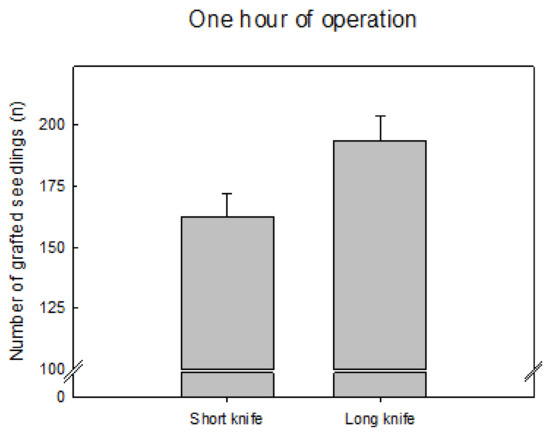
Figure 11.
The number of grafted seedlings that can be completed by two kinds of oblique cutting structures and grafting personnel within one hour of operation.
From the above results, it is evident that the short-knife and the long-knife types do not affect the time for the machine itself to process scion and stock seedlings, but it does affect the smoothness of the grafter when using the casing grafting process, the long-knife type more efficiently grafting seedling.
3.4. Survival Rate of Grafted Seedlings
After the short and long knives obliquely cut the scion and stock seedlings, the grafter uses the casing to graft them. Three trays of grafted seedlings were completed for each of the two types, with a total of 624 plants, after which the grafted seedlings were healed and domesticated. After 14 days, the survival rates of the two types of grafted seedlings were recorded, as shown in Table 6.

Table 6.
The survival rate of grafted seedlings using two types of oblique cut structures.
The survival rate of the grafted seedlings with the short-knife oblique cutting structure is 83.33%, and that of the long-knife oblique cutting structure is 84.94%. There is no significant difference between the two based on the t-test analysis, showing that different types of oblique cut structures do not affect the survival rate of grafted seedlings. The factors affecting the survival and growth performance of grafted seedlings are discussed below:
- Differences in the bevel angles of the scion and stock seedlings: The seedling trait differences and sowing positions all affect the bevel angle, especially for eggplant seedlings. Slanted or knotted stems at the clamping position affect the beveling angle, resulting in poor adhesion between the scion and beveled rootstock, poor cell healing and cambium connection between the two, resulting in graft failure.
- Grafting time and healing environment: The scion and rootstock should be joined immediately after the seedlings are cut obliquely, because when the seedlings are injured, a gangrene layer forms to help the joints bind. If the scion and rootstock are not joined immediately after beveling, the water on the beveled surface evaporates over time and the cells die, which affects the healing of the grafted seedlings [22]. Consequently, it is recommended that the grafted seedlings are sent to the healing room within half an hour of completing the grafting process. The healing room environment should be in high humidity conditions (85–95% RH), which is conducive to the formation of callus and healing.
- Differences in oblique cutting position of the root anvil: Grafted seedlings whose oblique cutting position is above the cotyledon exhibit better growth performance than grafted seedlings whose oblique cutting position is below the cotyledon, but the difference in position has no effect on their survival [23]. However, grafted seedlings whose root anvil is obliquely cut above the cotyledon will produce new branches on the root anvil, which need to be removed from time to time, increasing labor costs. Consequently, it is recommended that the oblique cut position of the root anvil be below the cotyledon to avoid unnecessary branch growth [24].
3.5. Economic Benefit
This device can do difficult oblique cutting, supply ears, and prepare seedlings continuously and stably; therefore, it can reduce employee’s fatigue and work injuries, and shorten the training time. According to interviews with nursery industry operators, the device can also respond to the situation of labor shortage and the lack of workers with professional cutting skill during the busy season. In terms of machine production cost, we can use 3D printing machines to manufacture the clamping and beveling device; the cost is about NT$20,000. The cost of the mechanical arm is about NT$300,000–600,000 and the cost of the control components is about NT$ NT$20,000. The estimated cost to manufacture the device is about NT$650,000. In Taiwan, the profit rate of grafted seedlings was increased from 16.82% to 39.68% [25]. The cost of machinery can be amortized when the production value reaches NT$3.86 million.
4. Conclusions
This clamping and cutting arrangement-type device with a UR5 robotic arm has a simple structure and can automatically clamp and bevel the stock seedlings of different Solanaceae panicles. It can accommodate multiple seedlings in a single operation, improving operational efficiency. In the proposed device, the gripping structure worked well using the pneumatic MHL2 gripper, which could firmly clamp multiple seedlings simultaneously; the oblique cutting structure exhibited a high success rate using a long knife, which could adapt to the shape of the seedlings. Additionally, with amateur grafters, the time to complete a plate of grafted seedlings using the long-knife type was 1.19 times faster than that of the short-knife type. In the 4-seedling mode, the machine could process 404 eggplant seedlings and 384 tomato seedlings in one hour and 194 grafted seedlings with amateur grafters. If the machines and humans are trained to better coordinate with one another, there is enormous potential to increase productivity. After the grafted seedlings were healed and domesticated, the average survival rate reached 85%. In the future, a test of x seedlings should be conducted in a single operation. Moreover, the plan is to move the proposed machine to a cooperative seedling producer for testing with professional grafters and continue to improve it so that it can be applied in practice. The device used in this study has a simple structure and wide applicability and can be used with different grafting machines to improve the automation of grafting operations.
5. Patents
The Clamping and Cutting Arrangement Device for Solanaceae Scion and Stock Seedlings was approved as autility model patent by Intellectual Property Office, MOEA in 2020 (certificate number: M600527).
Author Contributions
Conceptualization and validation, C.-Y.C. and Y.-C.H.; writing—original draft preparation, C.-Y.C., Y.-C.H. and W.-L.C.; writing—review and editing, Y.-I.H. All authors have read and agreed to the published version of the manuscript.
Funding
This research was funded by Council of Agriculture, Executive Yuan, grant number 108AS-7.4.1-CS-D2 and The APC was funded by https://project.coa.gov.tw/.
Institutional Review Board Statement
Not applicable.
Informed Consent Statement
Not applicable.
Data Availability Statement
Data are contained within the article.
Acknowledgments
Thanks to the colleagues in the Taichung District Agricultural Research and Extension Station for their assistance in the experimental research.
Conflicts of Interest
The authors declare no conflict of interest.
References
- FAOSTAT 2019 Database. Available online: http://www.fao.org/faostat/zh/#data (accessed on 20 September 2021).
- Lee, J.-M.; Kubota, C.; Tsao, S.J.; Bie, Z.; Echevarria, P.H.; Morra, L.; Oda, M. Current status of vegetable grafting: Diffusion, grafting techniques, automation. Sci. Hortic. 2010, 127, 93–105. [Google Scholar] [CrossRef]
- Kumar, P.; Rouphael, Y.; Cardarelli, M.; Colla, G. Vegetable grafting as a tool to improve drought resistance and water use efficiency. Front. Plant Sci. 2017, 8, 1130. [Google Scholar] [CrossRef] [PubMed]
- Salaria, M.; Relhan, A.; Rawat, M. Grafting as a strategy for the improvement of cucurbits and Solanaceous vegetables: A review. Plant Arch. 2020, 20, 6201–6206. [Google Scholar]
- Urlić, B.; Runjić, M.; Mandušić, M.; Žanić, K.; Selak, G.V.; Matešković, A.; Dumičić, G. Partial root-zone drying and deficit irrigation effect on growth, yield, water use and quality of greenhouse grown grafted tomato. Agronomy 2020, 10, 1297. [Google Scholar] [CrossRef]
- Rouphael, Y.; Venema, J.H.; Edelstein, M.; Savvas, D.; Colla, G.; Ntatsi, G.; Ben-Hur, M.; Kumar, P.; Schwarz, D. Grafting as a tool for tolerance of abiotic stress. In Vegetable Grafting: Principles and Practices; Colla, G., Pérez-Alfocea, F., Schwarz, D., Eds.; CAB International: Oxfordshire, UK, 2017; pp. 171–215. [Google Scholar]
- Singh, H.; Kumar, P.; Kumar, A.; Kyriacou, M.C.; Colla, G.; Rouphael, Y. Grafting tomato as a tool to improve salt tolerance. Agronomy 2020, 10, 263. [Google Scholar] [CrossRef]
- Kyriacou, M.C.; Rouphael, Y.; Colla, G.; Zrenner, R.M.; Schwarz, D. Vegetable grafting: The implications of a growing agronomic imperative for vegetable fruit quality and nutritive value. Front. Plant Sci. 2017, 8, 741. [Google Scholar] [CrossRef] [PubMed]
- Singh, H.; Kumar, P.; Chaudhari, S.; Edelstein, M. Tomato grafting: A global perspective. HortScience 2017, 52, 1328–1336. [Google Scholar] [CrossRef]
- Rouphael, Y.; Kyriacou, M.; Colla, G. Vegetable grafting: A toolbox for securing yield stability under multiple stress conditions. Front. Plant Sci. 2018, 8, 2255. [Google Scholar] [CrossRef] [PubMed]
- Wang, S.T.; Hseu, S.H. Production of tomato with grafting seedlings under protected cultivation. In Proceedings of the Symposium on Pest Management and Safety of Facility Cultivation; Taiwan Agricultural Research Institute: Taichung, Taiwan, 2017; pp. 64–75. [Google Scholar]
- Chang, C.Y.; Tien, Y.S.; Lin, H.S. Symposium on New Trends of Seedling Industry Development; Tainan District Agricultural Research and Extension Station, COA: Tainan, Taiwan, 2015; pp. 99–106. [Google Scholar]
- Chen, W.L.; Pai, K.F.; Yang, J.L. Vegetable Grafted Seedling Production and Mechanical Application Technology; Taichung District Agricultural Research and Extension Station, COA: Taichung, Taiwan, 2016. [Google Scholar]
- Chang, C.Y.; Tien, Y.S. Development and application of conveyor type grafting auxiliary machinery. In Proceeding of 2019 Symposium on Development and Application on Labor-Saving Agricultural Machinery; Taichung District Agricultural Research and Extension Station, COA: Taichung, Taiwan, 2019. [Google Scholar]
- Hung, Y.C.; Chang, C.Y.; Tien, Y.S. Development and Application of the Arrangement Device of Clamping and Cutting of Solanaceae Scion and Stock Seedlings; Taichung District Agricultural Research and Extension Station, COA: Taichung, Taiwan, 2020; Volume 147, pp. 1–13. [Google Scholar]
- Belforte, G.; Raparelli, T.; Eula, G.; Sirolli, S. An Innovative Automatic Tomato Grafting Machine Prototype. J. Eng. Sci. Technol. 2022, 17, 2272–2286. [Google Scholar]
- Bausher, M.G.; Road, S.R.; Pierce, F. Graft angle and its relationship to tomato plant survival. HortScience 2013, 48, 34–36. [Google Scholar] [CrossRef]
- Pardo-Alonso, J.-L.; Carreño-Ortega, Á.; Martínez-Gaitán, C.-C.; Callejón-Ferre, Á.-J. Combined influence of cutting angle and diameter differences between seedlings on the grafting success of tomato using the splicing technique. Agronomy 2018, 9, 5. [Google Scholar] [CrossRef]
- Johnson, S.J.; Miles, C.A. Effect of healing chamber design on the survival of grafted eggplant, tomato, and watermelon. Horttechnology 2011, 21, 752–758. [Google Scholar] [CrossRef]
- Buajaila, F.A.; Devi, P.; Miles, C.A. Effect of environment on survival of eggplant, pepper, and tomato in a small-scale healing chamber. HortTechnology 2018, 28, 668–675. [Google Scholar] [CrossRef]
- Bliss, C.I. The transformation of percentages for use in the analysis of variance. Ohio J. Sci. 1938, 38, 9–12. [Google Scholar]
- Chang, Y.C. Effect of acclimatization environment condition on grafted seedlings growth of ‘Asian No. 6′ tomato. J. Chinese Soc. Hort. Sci. 2004, 50, 405–420. [Google Scholar]
- Kim, S.H.; Pham, T.D.; Kim, I.S. Effect of grafting position, water content in substrate on the survival rate and quality of grafted tomato seedlings. J. Agric. Life Environ. Sci. 2016, 27, 13. [Google Scholar]
- Johnson, S.; Kreider, P.; Miles, C. Vegetable Grafting: Eggplants and tomatoes. 2013. Available online: http://pubs.cahnrs.wsu.edu/publications/wp-content/uploads/sites/2/publications/fs052e.pdf (accessed on 19 February 2020).
- Chen, S.F.; Chang, C.Y.; Tien, Y.S. Benefit Analysis of Semiautomatic Grafting Machines Applied for Cherry Tomato Seedling Nursery Farm; Taichung District Agricultural Research and Extension Station, COA: Taichung, Taiwan, 2016; Volume 131, pp. 45–55. [Google Scholar]
Disclaimer/Publisher’s Note: The statements, opinions and data contained in all publications are solely those of the individual author(s) and contributor(s) and not of MDPI and/or the editor(s). MDPI and/or the editor(s) disclaim responsibility for any injury to people or property resulting from any ideas, methods, instructions or products referred to in the content. |
© 2023 by the authors. Licensee MDPI, Basel, Switzerland. This article is an open access article distributed under the terms and conditions of the Creative Commons Attribution (CC BY) license (https://creativecommons.org/licenses/by/4.0/).